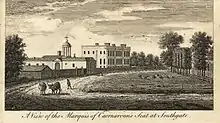Sir Thomas Wolstenholme, 2nd Baronet
Sir Thomas Wolstenholme, 2nd Baronet (c. 1622–1691) was an English baronet.

Minchington Hall as it appeared around 1776 in Robert Goadby's A New Display of the Beauties of England (1776).[1]
The Wolstenholme family acquired wealth and social position in Middlesex through service in the customs office. The second baronet built Minchington Hall in Southgate, Middlesex, after 1664. In 1672 he was assessed to taxation on 35 hearths, the greatest amount in the parish.[2] In 1675 he settled £2,000 PA in lands on his son the future 3rd baronet when he married into the powerful Raynton family. In 1690, the 3rd baronet, by then a member of Parliament for Middlesex petitioned Parliament for a bill to sell several properties to pay the debts of his father, who it was claimed, was almost bankrupt.[3]
See also
References
- [Goadby, Robert.] (1776) A New Display of the Beauties of England &c. Vol. I. 3rd edition. London: R. Goadby. p. 156.
- Edmonton: Other estates. British History Online. Retrieved 26 December 2018.
- WOLSTENHOLME, Sir John, 3rd Bt. (1649-1709), of Forty Hall, Enfield, and Denmark Street, St. Giles-in-the-Fields, Mdx. History of Parliament. Retrieved 26 December 2018.
| Baronetage of England | ||
|---|---|---|
| Preceded by John Wolstenholme |
Baronet (of London) 1670–1691 |
Succeeded by John Wolstenholme |
This article is issued from Wikipedia. The text is licensed under Creative Commons - Attribution - Sharealike. Additional terms may apply for the media files.
